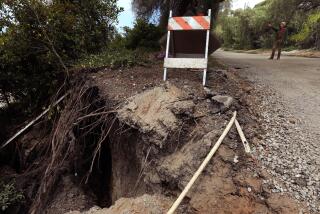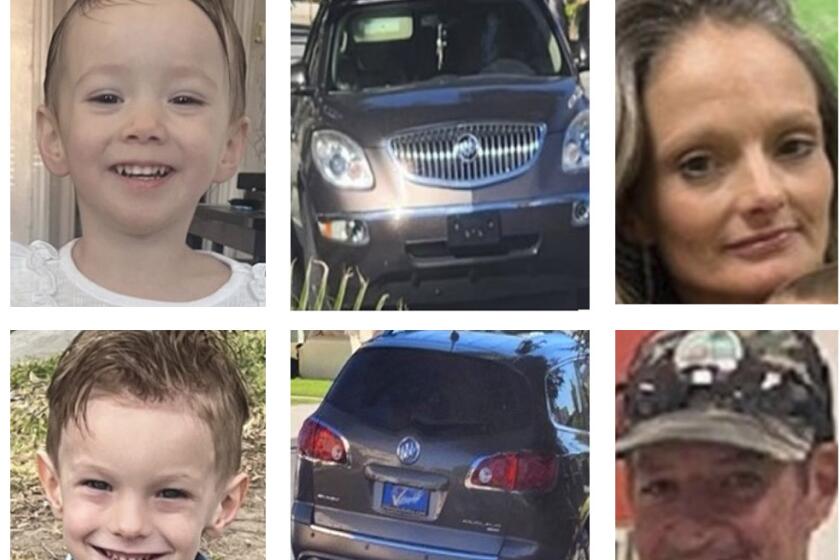Safety Measures Questioned as ATM Robberies Increase
Since their creation 20 years ago, automated teller machines have been a bandit’s dream--a source of fast cash and easy getaways. But in recent months, several highly publicized ATM robberies have prompted worries that customers of the proliferating machines are becoming increasingly attractive targets.
“It is the crime of the ‘90s,” said state Sen. Charles M. Calderon (D-Whittier), a crusader for better ATM safety measures. “The problem is much worse than we’ve ever imagined.”
Two weeks ago, a Sacramento woman was abducted from an ATM, raped and shot in the head. In Hollywood the week before, a 28-year-old newlywed was killed during a cash-machine robbery on Sunset Boulevard. In a series of San Gabriel Valley murders earlier this year, two victims were driven to ATMs before they were killed.
And in a 1989 case that drew national attention, a prominent Jewish leader, Jerome Weber, was fatally shot over $40 at a West Los Angeles ATM.
Experts say it is not surprising that examples of ATM crimes are getting easier to find: In 1985, there were 52,500 ATMs nationwide. Today, there are an estimated 81,000, with more than $6 million annually passing through each one.
Although bank officials insist that the situation is being overblown, Gerald Arenberg of the Miami-based National Assn. of Chiefs of Police calls ATM robberies “a major problem.”
“Those things are open 24 hours a day and loaded with money,” Arenberg, the association’s executive director, said. “There are too many people being killed and robbed.”
A top official in the Los Angeles County district attorney’s office estimates that, based on conversations with prosecutors and police officers, there are as many as half a dozen ATM robberies in the county every day.
“And how many cases don’t get to us, I can’t begin to tell you,” said Deputy Dist. Atty. Norman Shapiro, head of the criminal complaints division. “It’s obvious that a person is a sitting duck--the robber knows someone is coming up with as much as $500 now when they go to an ATM. They do one and they get brazen.”
Shapiro recalled that this year a Hollywood man considered to be the most prolific ATM bandit in the United States was convicted of committing at least 37 ATM robberies and attempted robberies across the county. He was sentenced to 28 years in prison.
Recognizing the potential dangers of ATMs, the Los Angeles County Sheriff’s Department has installed a cash machine at its state-of-the-art training facility, Laser Village, where deputies learn when to shoot their guns. Two of the department’s fatal shootings this year were by off-duty deputies defending themselves against would-be robbers at ATMs.
Banking officials and trade associations, for their part, say the ubiquitous cash machines are safe, and getting safer with the advent of new security features.
Sean Kennedy, president of the Electronic Funds Transfer Assn., said surveys by his group and bank associations show that there is only one attack in every 2 million to 3 million transactions. “The odds are greater,” he said, “that you’d be struck by lightning.”
But no one knows the true dimensions of the problem--not the banks, not the critics, not even the police. The reason is that virtually every law enforcement agency in the country includes ATM-related crimes and injuries with other robberies, making no distinctions.
The Los Angeles Police Department is about to break ranks and change its crime-reporting policies to specifically reflect how many people are being robbed and assaulted at ATMs. “Anybody who ventures even a guess is foolish,” said Los Angeles Police Lt. Ron Lewis, “because we just don’t know.”
Lewis said the reporting system--thought to be the first under consideration by a major metropolitan police force--was advocated by the “vast, vast majority of detectives” who say it is crucial to the department’s ability to predict and combat ATM robberies.
Moreover, with better documentation of the problem, banks would be compelled under a new state law to enhance security at high-risk machines, an important benefit in Los Angeles, where the Police Department has fewer officers per capita than any other major city, Arenberg said.
With its proposed reporting system, the Police Department has placed itself at the center of a national debate over whether all law enforcement agencies should be required to collect ATM crime statistics as a way to get a fix on the problem.
A bill by Calderon that would require such crime statistics is pending in the Legislature. On the national level, the banking industry’s lobby has thwarted efforts to regulate ATM safety or require the compilation of ATM crimes.
James Clark, chief lobbyist for the California Bankers Assn., said the state’s financial institutions would probably support mandatory crime-reporting requirements “so we can find out what’s really going on.” But only, he said, if police do not include crimes that are indirectly linked to cash machines.
He cited the case of a Chicago woman murdered in 1989 after bandits took her to an ATM to rob her of $400. “Is that an ATM crime,” Clark asked, “or an abduction?”
Initially, California banks strongly fought efforts to regulate ATMs, but have softened their stance in recent years--”when they understood they had a major problem on their hands,” Calderon said.
The lawmaker has been a leading advocate for placing stricter controls on ATMs and requiring banks to take greater responsibility for their customers’ safety. His campaign began four years ago when a constituent was killed in a cash-machine holdup.
Last year, he pushed through an ATM-safety bill requiring banks to provide adequate lighting, safe locations and landscaping, consumer tips and other safety measures. Although the legislation was watered down--Calderon had wanted guards and surveillance cameras at high-risk ATMs--the bill was the first of its kind in the nation. And Calderon says it is just a first step.
“If they (the banks) are inviting depositors on the premise of 24-hour access,” Calderon said, “they have a responsibility to anticipate dangers that may be present. . . . Women have been raped at ATMs and robbed. Men have been robbed at ATMs and murdered.”
Banking officials say most legally mandated safety and crime-reporting requirements are unnecessary because they already are doing their best to protect customers. They say they are monitoring crime levels while providing better lighting, locations and even enclosed vestibules. Cash machines, they say, are far safer than gas stations and convenience stores.
Others question the banks’ safety claims and statistics. Spencer Nilson, publisher of a Santa Monica-based newsletter on banking credit cards and ATMs, said that “banks want to gloss over the problem. . . . I don’t trust them.”
Nor does Sally Weber, the widow of the Encino man killed in 1989 at a west Los Angeles ATM. She alleges that she and her husband were ambushed because the bank had failed to provide adequate lighting at its cash machine and located it away from broad public view.
“None of the safeguards that you find inside a bank--security guards, lighting, panic buttons, video cameras--can be found outside, at ATMs,” said Weber, who has filed a multimillion-dollar wrongful death suit against Wells Fargo Bank.
As the case moves toward trial, banks everywhere are watching closely, fearful that a judgment against one bank could force them all to pay for security guards and other expensive safety measures--or risk liability.
“They’d be fools not to watch,” said bank lobbyist Clark. “What the court says could have tremendous implications . . . on what type of services banks offer.”
ATM ALERT TOWARD A SAFER SITE Here are some of the improvements suggested by safety advocates that some banks are implementing: 1. Install ATMS or move them to safe locations where they are in plain view of the street, 24-hour businesses or security guard stations. 2. Enhance visibility, cutting down hedges and knocking down walls that keep machine from public view. 3. Install fencing to limit access to more dangerous property adjacent to ATM. 4. Improve lighting at the ATM, in the nearking parking area and in the connecting pathways. 5. Install security cameras, audio monitoring devices, rear-view mirrors and other physical security devices. 6. Construct a card-access vestibule around the ATM. HELPFUL HINTS Here are some safety suggestions for customers using ATM: * Park your car in a well-lighted area, and use only well-lighted ATMS. * Avoid ATMS with nearby hedges or other hiding places. * If you must use an ATM after dark, have someone accompany you. * Be wary of all strangers, especially those who crowd you or attempt to view your transaction. * Minimize time spent at an ATM machine. Have your card ready and all forms filled out. After your transaction, put items away and leave quickly. * When using a drive-up machine, be sure all windows but the driver’s are closed and the doors locked. Keep your engine running. * Never keep your code numbers in your wallet, and take your receipt with you. * Always be alert and aware of your surroundings. * If you have any doubts, fears or concerns, postpone or cancel your transaction and go to another location. * Report all ATM-related crimes to your financial institution and to police. SOURCE: Various police agencies and the Electronic Funds Transfer Assn.
More to Read
Sign up for Essential California
The most important California stories and recommendations in your inbox every morning.
You may occasionally receive promotional content from the Los Angeles Times.





